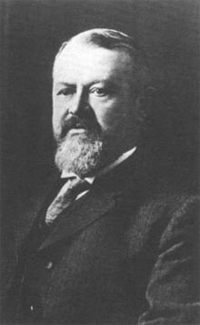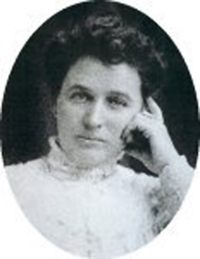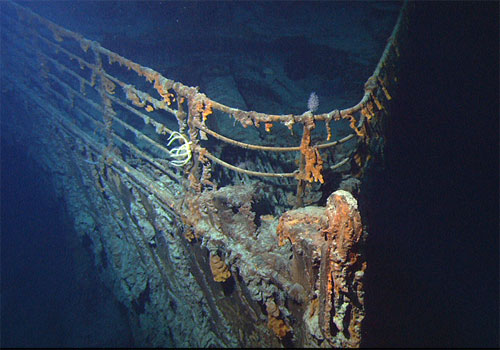
By DAVE KIFFER April 09, 2012
Prince Rupert was Hay’s baby, a community that the Canadian railroad titan saw as someday being as important as Seattle and Vancouver. He had chosen Kaien Island on the northwestern coast of British Columbia for the terminus of the second Canadian trans-continental railway because it was several days sailing closer to Asia. In 1906, he sent work crews to begin carving the community out of the wilderness. (see “Prince Rupert: Hay’s Orphan Looks To The Future,” SITNEWS, February 28, 2007) Then, on April 10, 1912, he boarded the Titanic. Like several other important Canadian railroad pioneers, Charles Melville Hays was actually American, born on May 16, 1856 in Rock Island, Illinois and raised in St. Joseph, Missouri. When he was 17 he went to work for the Missouri Pacific Railway and by 1884 he was working his way up in the hierarchy of the Wabash, St. Louis and Pacific Railway. He became general manager of the entire line in 1889. In 1895, American financier J.P. Morgan recommended Hays for the job of leading the Grand Trunk Railway, a Canadian-American company that was financed largely by British investors. Ironically, among Morgan’s other business interests was the International Mercantile Marine Company, which later controlled the White Star Line, the owners of the Titanic. With the board of directors of the Grand Trunk living mostly in London, it was decided that General Manager L.J. Sergeant should move to England to advise the board on railroad matters and Hays was asked to fill the position of day-to-day management of the line back in Canada. Gavin Murphy, who wrote a brief history of Hays for the Historical Society of Ottawa in 1992, quoted the Railway Gazette as noting that Hays was “very self-possessed, seldom showing irritation or anger and his capacity for work seemed unlimited.” Hays was also described as stocky, with a neat beard and keen eyes and called “the Little American.” Hays moved to Montreal to manage the line. “His experience and contacts with American railways helped Grand Trunk sign advantageous agreements with connecting roads in the USA,” Murphy wrote, adding that Hays also built grain facilities in Montreal and Maine to boost shipping on the line. Hays left the Grand Trunk in 1901 to become the president of the Southern Pacific Railway, but returned only a few months later with increased job duties at Grand Trunk. By 1902, he had turned a half million dollar operating loss on his arrival to a $1 million surplus. In 1903, he led the line into its most significant expansion; one that would be considered highly controversial a decade later when Grand Trunk suffered financial reverses and eventually went bankrupt. Nearly 30 years before, the Canadian Government had tried to convince the Grand Trunk to undertake Canada’s first cross-country line and the company had deferred. That line was eventually built to Vancouver by the Canadian Pacific. Now in 1903, Grand Trunk – at Hays’ urging – decided the time was right for a second line to the coast. This one would follow a northern route. Initially, Hays chose the Pacific terminus to be Port Simpson, an established community just south of the Alaskan border. But preliminary engineering studies came up with a better site. Kaien Island, to the south, which had one of the best deep water ports along the entire coast. The new location would be 500 miles closer to Asia than Seattle and Vancouver. The Grand Trunk Pacific Railway was incorporated in 1903 and Hays was made president in 1905. He immediately began planning for the terminus in Prince Rupert (see “Prince Rupert Turns 100” SITNEWS, March 8, 2010). According to Murphy, Hays even sent his brother David to Prince Rupert to begin planning the town site and selling real estate. “It was to be a model town and the first in Canada to be planned on paper before any substantial construction,” Murphy wrote. Included in the planning was a glamorous hotel 450 room hotel similar to the Empress in Victoria and also designed by the Empress’s renowned architect Francis Rattenbury. For years, the plans for the hotel were thought lost until they were found in a Victoria attic in the mid 1990s. Hays also envisioned other great hotels along the line including the $1.5 million Chateau Laurier in Ottawa, named after the long serving Canadian Prime Minister Wilfred Laurier who was an ardent support of Hays’ efforts to build a second transcontinental railroad. The Chateau Laurier was scheduled to open on April 26, 1912, along with a brand new $525,000 railway terminal in the Canadian capital city. In the spring of 1912, Hays went to Europe with a three-fold mission. One was to vacation in Europe with his wife, daughter and son in law. He also planned to study hotel architecture and meet with European hotel officials to talk about management of his new chain. There was also a board meeting of the Grand Trunk board to attend, to help allay some concerns that his plans for the railway and the hotels were beginning to cost more than expected, especially with revenues from the new line still well off into the future. The Hays party included his wife, Clara, his daughter Orion Davidson, 28, her husband Thornton Davidson, 32, a stockbroker and former professional hockey player who was being groomed for a management role in the railroad, Mrs. Hays maid – Anne Perreault – and Hays private secretary, Vivian Payne. Murphy wrote that Hays was originally planning to return to North America in late April, but decided to come back earlier on the Titanic’s maiden voyage because he wanted to be in Ottawa in plenty of time for the opening of the Chateau Laurier. He was also concerned because another daughter, Louise, was having a difficult pregnancy. Hays was traveling on the Titanic as a personal guest o f White Star Line chairman J. Bruce Ismay, who was also to be on the voyage. Hays’ party was booked into four first class cabins. The Hays’ were in cabin B-69, the Davidson's were next door in B-71 and Perreault and Payne were in B-73 and B-24. They were traveling on a single ticket and paid 93 pounds, 10 shillings, which translates to more than $8,000 today. But that amount was basically half of what similar accommodations would have cost on the ship, because the Hays’ party were guests of Ismay.
View of the bow of the RMS Titanic photographed in June 2004 by the ROV Hercules during an expedition returning to the shipwreck of the Titanic.
According to the Encyclopedia Titanica website, which has bios of many of the passengers, Hays arrived at the Grand Trunk Board meeting looking “tired and fagged” from his efforts, according to board chairman Alfred Smithers. Hays decided to rest for several days at Smithers’ country estate before boarding the Titanic for the voyage home. Although at times it seems to modern readers that the five days between April 10 and April 15, 1912 on the Titanic is one of the most chronicled weeks in history, there was surprisingly little written about Charles Hays and his party by either the survivors or the numerous other writers in the past century. Many survivors, like John Thayer, mentioned meeting Hays and having conversations with him, but didn’t go into detail. Colonel Archibald Gracie survived the sinking but died a year later after publishing “Titanic: A Survivor’s Story.” He remembered a poignant conversation with Hays the afternoon before the ship struck the fatal iceberg. “The pleasure and comfort which all of us enjoyed upon this floating palace, with its extraordinary provisions for such purposes, seemed an ominous feature to many of us, including myself, who felt it almost too good to last without some terrible retribution inflicted by the hand of an angry omnipotence,” Gracie wrote, no doubt with some benefit of hindsight. But he noted that Hays had expressed similar concerns. “Our sentiment in this respect was voiced by one of the most able and distinguished of our fellow passengers, Mr. Charles M. Hays, President of the Canadian Grand Trunk Pacific Railroad,” Gracie wrote. “Engaged as he then was in studying and providing the hotels along the line of new extensions to his own great railroad system, the consideration of the subject and of the magnificence of the Titanic’s accommodations was thus brought home to him.” Gracie then wrote that Hays uttered a very prophetic line. “ ‘ The White Star, the Cunard and the Hamburg-American lines,’ said he, ‘are now devoting their attention to a struggle for supremacy in obtaining the most luxurious appointments for their ships and in making speed records, but the time will soon come when the greatest and most appalling of all disasters at sea will be the result.’ “ That time would be closer than either man could imagine, just a few hours. When the ship went down, it would take Hays, Davidson, Payne and more than 1,500 other passengers with it. The three female members of the Hays party would all survive. Encyclopedia Titantica places the conversation between Gracie and Hays at only an hour before the collision, but it doesn’t indicate where that information came from. In his memoir, Gracie just notes it was “hours” before the collision. One modern author, British writer Richard Davenport-Hines In his 2012 book “Voyagers of the Titanic” did write about Hays, but was clearly not in enamored with Hays or his railway. “..by 1912 the company’s debts were immense,” … Davenport-Hines wrote. “Hays’ solution – which smacks of blind obstinacy or unreasonable pride – was to spend more money…Some considered that Hays had deceived his London director about the Grand Trunk Pacific project: his policies certainly lured the railway headlong toward insolvency.” According to Murphy, Hays and Davidson escorted their wives to Lifeboat No. 3, placed fur coats around their shoulders, stepped back and waved goodbye. That lifeboat left the ship around 1 pm, about 80 minutes after the collision and another 90 minutes before the Titanic sank. “Goodbye,” Hays reportedly told his wife.”This ship is good for ten hours.” Earlier, when Hays and Arthur Peuchen, another Canadian traveling in First Class, inspected the ice on the deck, Peuchen – who survived - wrote that Hays said the ship would easy float for another “8 to 10 hours.” But it sank within three. Initially, in the confusion that followed the sinking it was reported in Montreal on April 16 that he had survived. But then the Montreal Daily Star reported later that day that he was not among the survivors on the R.M.S. Carpathia. “Abandon Hope for C.M. Hays” read the headline. Murphy wrote that all the celebrations of the new hotel and the railway station in Ottawa were cancelled in the wake of Hays death. The hotel simply opened for business on June 1. 1912 with Laurier signing the guest book as the first guest. Hays death was headlined in newspapers throughout Canada. On April 19th, The Montreal Herald noted it was a “national loss.” “Exactly how much good he wrought for the land of his adoption will very likely be not fully realized until his deeds are viewed in the perspective which only distance of time can give to a contemplation of the gigantic schemes which he fathered and carried to brilliantly successful conclusions,” the paper wrote. “The achievements of Mr. Hays have been so colossal that the man himself has at times been in danger of being overlooks in a survey of the great things which he accomplished.” There was a moment of tribute on the Grand Trunk line at 11:30 am on April 25, 1912 when every train and all work stopped. The next day Hays’ body was recovered by a ship hired by the White Star Line, the Nova Scotia cable ship, Minia. Murphy quotes the Minia’s wireless operator as telling his mother that it was easy to identify Hays’ body because had papers and a watch with his name on it. Hays was interred at Montreal’s Mount Royal Cemetery. His wife lived to age 96 and was buried with her husband. Although many survivors and relatives, including most of the other first class passengers, sued the White Star Line, the Hays’ family was not among them. Murphy wrote that Mrs. Hays was reported to have said “when one is a guest, one does not sue one’s host.” In the years after his death, Hays reputation took a beating. Primarily because his efforts to drive the railway all the way to Prince Rupert caused financial ruin for the Grand Trunk, which eventually declared bankruptcy and was nationalized after World War I. Out of that came the Canadian National Railway, which was formed from the Grand Trunk, Grand Trunk Pacific, Canadian Northern and National Transcontinental. Prince Rupert would continue on, but without its founder and his ideas for its future. Nearly a century after his death, a large container port would open hoping to take advantage of the fact it was – as Hays first noted – 500 miles closer to Asia.
On the Web:
Contact Dave at dave@sitnews.us
Publish A Letter in SitNews Read Letters/Opinions
|
|||


